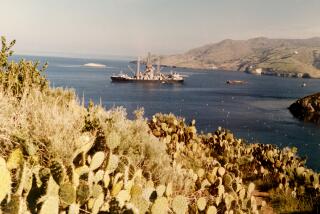Excavation Targets Ill-Fated Civil War-Era Sub
- Share via
Virtually every schoolchild has heard of the Monitor and the Merrimac, the Civil War ironclads that slugged it out in the first battle between ships of steel. Their arrival changed naval warfare forever, dooming the wooden frigate and ushering in the modern maritime era.
Few, however, are aware of their equally innovative sister ship, the Confederate vessel Hunley, the first functioning submarine. Although the Hunley carried three separate crews to the bottom of Charleston Harbor, it was the first submersible to sink an enemy battleship in war--a feat that would not be replicated until World War I.
The Hunley was largely forgotten until May 1995, when a team from the National Underwater and Marine Agency headed by adventure novelist Clive Cussler located the unlucky vessel lying intact and upright under 30 feet of water, sand and silt on the floor of the South Carolina harbor, four miles off Sullivan’s Island.
That discovery spurred new interest in the ship and led directly to the production of the TNT movie “The Hunley,” airing Sunday, as well as plans to bring the ill-fated vessel to the surface in the spring of 2001. The sub is also the focus of a new exhibit at the Naval Museum in Washington, D.C.
Just last week, a team of archeologists and volunteers finished excavating the graves of the Hunley’s first crew, along with those of another two dozen Confederate soldiers, from their unlikely location beneath the bleachers of Johnson-Hagood Stadium on the campus of the Citadel in Charleston. After study, the remains will be buried with full military honors in Magnolia Cemetery, there joining the victims of the ship’s second one-way dive to the harbor floor. When the ship is retrieved, the bodies of the third crew will also receive a full military burial.
Louisiana merchants Horace Hunley, James McClintock and Baxter Wilson began construction of their first submersible in New Orleans in 1861, constructing a sleek but clumsy vessel that was little more than two large boilers welded together. When Union forces under Gen. Benjamin Butler were about to enter the city, the three inventors hastily sank their craft in the New Basin Canal and fled to Mobile, Ala., with their blueprints and drawings.
In a small machine shop located near the Mobile harbor, they constructed their second prototype, called the American Diver. They initially hoped to power it with an electric motor, and then with a small, custom-built steam engine, but neither approach proved feasible. Eventually, they settled on a hand crank, designed to be turned by four men.
In early February 1863, while the American Diver was being towed for tests, it sank in stormy seas off Fort Morgan at the mouth of Mobile Bay. The rusty hulk still lies hidden beneath the shifting sands of the Gulf Coast.
Undaunted, the team immediately began constructing a larger boat designed for a crew of nine. Its design foreshadowed many aspects of modern submarines, including diving planes, forward and aft ballast tanks and a snorkel. The snorkel could never be made to work, however, and the ballast tanks were emptied by unreliable hand-operated pumps.
With eight men on the crank, the 40-foot-long vessel could reach a top speed of around 4 knots (about 5 mph). When the hatches were closed for submersion, the commander would light a candle to provide the sub’s only light. When the candle was snuffed out by lack of air about 25 minutes later, he knew it was time to surface and open the hatches to admit fresh air.
The new vessel was completed in early July 1863 and shipped on two railroad flatcars to Charleston, where its designers hoped it could be used to break the continuing naval blockade of Charleston Harbor.
The vessel sank twice during test runs in the harbor, in both cases due to pilot error. The first time, four members of the crew managed to escape through the hatches, but five died. The second time, all nine crew members went down with the ship, including Horace Hunley himself.
Army Lt. George Dixon supervised the recovery of the Hunley and fitted her out for one more chance, despite the observation by commanding Gen. Pierre G.T. Beauregard that “it’s more dangerous to those who use it than to the enemy.”
On the moonlit night of Feb. 17, 1864, the Hunley sneaked up on the 1,240-ton federal warship Housatonic and rammed it with a torpedo containing 90 pounds of black powder. As the sub withdrew, the Housatonic was rocked by an explosion that sank it in minutes.
Archeologists speculate that the force of the blast also damaged the Hunley, which never made it back into port.
More to Read
Sign up for Essential California
The most important California stories and recommendations in your inbox every morning.
You may occasionally receive promotional content from the Los Angeles Times.













